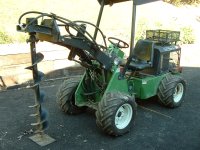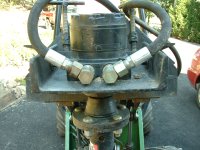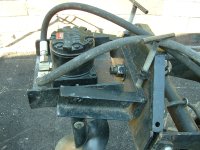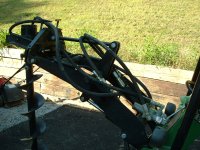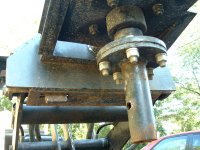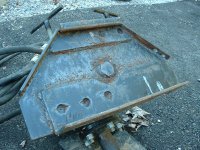Gravy
Platinum Member
At long last, I’m going to try to post some of the stuff I’ve done to “Kermit”, my PT-425. (I wrote most of this before I downloaded the digital photos, and I'm too lazy to figure out how to tie them in at the appropriate points. I'll just attach them all at the end.)
I’ll begin with my doctoral dissertation, or “how I got my PhD”. (Yes, it’s a really bad joke). When I visited PT’s new showroom, I looked carefully at all of the attachments that I wanted but couldn’t afford. These included the Post Hole Digger or the Planter Drill Head (PhD, PdH,, what’s the difference?). I discovered that both of these implements are so simple that even I could build one!
They are nothing more than a hydraulic motor, some hoses and a valve, and a few chunks of steel to hold it all together and connect it to an auger bit. PT’s part numbering system evidently indicates the approximate displacement of the motor. A P142X14 (pt 425 wheel motor) has a displacement of about 14 cubic inches per revolution. Armed with this information, I went hunting.
I started with the motor. The Hydraulicsuperstore.com website showed a White Hydraulics motor that looked like what I saw in the showroom, and was available in a good range of displacements. I cross-referenced it to White’s website, and nailed it down as an RE-series motor. I didn’t keep a record of the exact part number, but that really isn’t an insurmountable problem. The details that really matter are: displacement, hose connections, and shaft configuration.
I wanted the motor to be useful for several purposes, so I decided to couple it via a standard wheel hub that fit a 1-1/4” tapered shaft. The motor on the website had a straight shaft, so I called the phone number and talked to a very helpful, patient lady who assured me that they could swap parts to get me what I wanted. A few days later, I had a 24 inch displacement motor with a tapered shaft for about $300.
I bought a matching 5-stud wheel hub from surpluscenter.com, along with several 5-hole hubs to mate with it. My plan was to bolt the two hubs face-to-face, giving me an easy way to convert motor functions. I intended to use the motor for a PhD and a winch, with vague ideas for other uses.
My plans were a bit unhinged when I realized that the matching hubs were made of cast iron, and that my very limited welding skills would not suffice to make them into universal adapters for all manner of implements. Disappointed, but not entirely daunted, I torched an adapter flange out of some steel plate from the scrap pile and welded it to a piece of water pipe. I cross-drilled the pipe, bought a $100 auger from TSC, and had the moving parts of my earth drill.
The mounting hardware was cobbled together from scrap purchased from a local forklift repair/general salvage business. I took measurements from a factory mounting plate and welded up a really ugly copy from plate and angle. I welded the angle to the face of the plate, which gave me some clearance for the bolt head.
I bought a 1” coarse thread Grade 8 bolt & nut (probably from TSC), torched a hole in the mounting plate, and proceeded to weld and grind. I’m better at grinding, but that’s not saying much.
The next item is the pivoting yoke. It’s made from scrap channel. It allows the motor to tilt for working sideways on a slope. I made t-handle screw mechanisms to allow me to lock in the angle. The idea was to combine the features of the PhD and the PDh. I’m pretty sure that was a waste of time. I’ve found I only drill from straight up or down hill. Otherwise, the PT slips sideways.
I mounted the motor to a chunk of large channel (8 or 10 inch – I’d have to go out in the dark to measure). More “precision” work with the cutting torch.
The next adventure was the plumbing. I bought 90-degree adapters and hoses from Surpluscenter.com. I later found that TSC stocks hoses at a fairly reasonable price as well. I used 1/2" hoses and couplers. I got my quick connects from a local hydraulic hose supplier. I bought a Prince motor spool valve from Northern Tool. Again, I don’t remember the part number, but I’m pretty sure it’s the only motor spool valve Northern sells. I spent some time trying to find a better price, but concluded that Northern is as good as it gets.
I had to grind off a bit of one of the 90 degree hose adapters so I could tighten it without running into the other one, but it hasn’t blown out after over 100 uses.
The assembly was now complete. I mounted the valve to the lift arms with my customary high-tech rubber bungees, and started drilling holes. Amazingly enough, the darn thing works! As I’ve mentioned before, my property is isn’t really rocky soil. It’s more of a dirty rock pile. Nonetheless, we drilled 96 12-inch holes 2 to 3 feet deep through clay, cobble and shale to plant blue rug junipers. We also used the 24-inch auger to plant a couple of small trees.
The valve comes preset to relieve at 2000psi, and I haven’t adjusted it to match the PT’s 2500psi settings. The auger would regularly stall out when it encountered the bigger rocks, but it got the job done.
However: If I were doing it again, I would use a smaller motor. The 24 incher has a bunch of torque, but it doesn’t spin fast enough to throw off cuttings with the smaller augers, and it still locks up on larger rocks. I think something on the order of 18 inches would be a better choice for up to 12 inch augers.
That's about all I've got time for now. I'll be happy to answer any questions, but I'll be out of town a lot for the next few weeks, so be patient.
Gravy
I’ll begin with my doctoral dissertation, or “how I got my PhD”. (Yes, it’s a really bad joke). When I visited PT’s new showroom, I looked carefully at all of the attachments that I wanted but couldn’t afford. These included the Post Hole Digger or the Planter Drill Head (PhD, PdH,, what’s the difference?). I discovered that both of these implements are so simple that even I could build one!
They are nothing more than a hydraulic motor, some hoses and a valve, and a few chunks of steel to hold it all together and connect it to an auger bit. PT’s part numbering system evidently indicates the approximate displacement of the motor. A P142X14 (pt 425 wheel motor) has a displacement of about 14 cubic inches per revolution. Armed with this information, I went hunting.
I started with the motor. The Hydraulicsuperstore.com website showed a White Hydraulics motor that looked like what I saw in the showroom, and was available in a good range of displacements. I cross-referenced it to White’s website, and nailed it down as an RE-series motor. I didn’t keep a record of the exact part number, but that really isn’t an insurmountable problem. The details that really matter are: displacement, hose connections, and shaft configuration.
I wanted the motor to be useful for several purposes, so I decided to couple it via a standard wheel hub that fit a 1-1/4” tapered shaft. The motor on the website had a straight shaft, so I called the phone number and talked to a very helpful, patient lady who assured me that they could swap parts to get me what I wanted. A few days later, I had a 24 inch displacement motor with a tapered shaft for about $300.
I bought a matching 5-stud wheel hub from surpluscenter.com, along with several 5-hole hubs to mate with it. My plan was to bolt the two hubs face-to-face, giving me an easy way to convert motor functions. I intended to use the motor for a PhD and a winch, with vague ideas for other uses.
My plans were a bit unhinged when I realized that the matching hubs were made of cast iron, and that my very limited welding skills would not suffice to make them into universal adapters for all manner of implements. Disappointed, but not entirely daunted, I torched an adapter flange out of some steel plate from the scrap pile and welded it to a piece of water pipe. I cross-drilled the pipe, bought a $100 auger from TSC, and had the moving parts of my earth drill.
The mounting hardware was cobbled together from scrap purchased from a local forklift repair/general salvage business. I took measurements from a factory mounting plate and welded up a really ugly copy from plate and angle. I welded the angle to the face of the plate, which gave me some clearance for the bolt head.
I bought a 1” coarse thread Grade 8 bolt & nut (probably from TSC), torched a hole in the mounting plate, and proceeded to weld and grind. I’m better at grinding, but that’s not saying much.
The next item is the pivoting yoke. It’s made from scrap channel. It allows the motor to tilt for working sideways on a slope. I made t-handle screw mechanisms to allow me to lock in the angle. The idea was to combine the features of the PhD and the PDh. I’m pretty sure that was a waste of time. I’ve found I only drill from straight up or down hill. Otherwise, the PT slips sideways.
I mounted the motor to a chunk of large channel (8 or 10 inch – I’d have to go out in the dark to measure). More “precision” work with the cutting torch.
The next adventure was the plumbing. I bought 90-degree adapters and hoses from Surpluscenter.com. I later found that TSC stocks hoses at a fairly reasonable price as well. I used 1/2" hoses and couplers. I got my quick connects from a local hydraulic hose supplier. I bought a Prince motor spool valve from Northern Tool. Again, I don’t remember the part number, but I’m pretty sure it’s the only motor spool valve Northern sells. I spent some time trying to find a better price, but concluded that Northern is as good as it gets.
I had to grind off a bit of one of the 90 degree hose adapters so I could tighten it without running into the other one, but it hasn’t blown out after over 100 uses.
The assembly was now complete. I mounted the valve to the lift arms with my customary high-tech rubber bungees, and started drilling holes. Amazingly enough, the darn thing works! As I’ve mentioned before, my property is isn’t really rocky soil. It’s more of a dirty rock pile. Nonetheless, we drilled 96 12-inch holes 2 to 3 feet deep through clay, cobble and shale to plant blue rug junipers. We also used the 24-inch auger to plant a couple of small trees.
The valve comes preset to relieve at 2000psi, and I haven’t adjusted it to match the PT’s 2500psi settings. The auger would regularly stall out when it encountered the bigger rocks, but it got the job done.
However: If I were doing it again, I would use a smaller motor. The 24 incher has a bunch of torque, but it doesn’t spin fast enough to throw off cuttings with the smaller augers, and it still locks up on larger rocks. I think something on the order of 18 inches would be a better choice for up to 12 inch augers.
That's about all I've got time for now. I'll be happy to answer any questions, but I'll be out of town a lot for the next few weeks, so be patient.
Gravy
